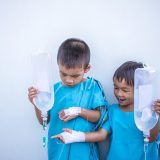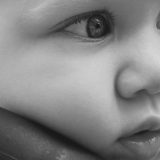Treating Retinoblastoma at Pediatric Cancer Centers
Pediatric retinoblastoma is a rare form of kids’ eye cancer that can be life threatening if it’s not treated quickly enough. Like all forms of child cancer, retinoblastoma is typically treated in specialized pediatric cancer centers. These cancer centers may stand alone or be part of large hospitals. Pediatric cancer centers offer a wealth of support for patients and their families, in addition to treatment. Who Is Treated at Pediatric Cancer Centers? Children from birth to age 18 or even 21 may be treated at pediatric cancer centers. Children with any form of cancer may receive treatments of all different types. Some of the children that are treated at cancer centers are treated on an outpatient basis, while others may have their own rooms and stay for an extended period of time. Lively Themes and Designs The children and families that utilize pediatric cancer centers are typically worried about the diagnosis, the upcoming treatments, and the potential prognosis after treatment. To take their minds off of the situation and let kids be kids as much as possible, most cancer centers are bright and lively, with toys and games in main areas. Even individual rooms may be colorful and have fun drawings and other child-friendly attributes. Play Therapy To help kids cope with their feelings and work through complex emotions, some cancer centers integrate creative play with other types of treatment. Doctors and therapists may bring props that will get kids laughing and encourage them to talk about their fears and thoughts. This type of therapy has shown to be effective for some patients. Cutting Edge Treatments Most pediatric cancer centers are supported by the Children’s Oncology Groupand the National Cancer Institute. This international network of support allows pediatric cancer centers to have access to some of the most cutting edge research, technology, and clinical trials. For pediatric retinoblastoma patients, this may increase the odds that vision will be retained while also combating the cancer. A Network of Peers One of the things that many families of children with pediatric retinoblastoma find most helpful about pediatric cancer centers is the network of peers that the center puts families in touch with. The other children and families present at the center are dealing with many of the same struggles, worries, and issues. It can be reassuring and helpful to have someone to talk to that is going through the same life changes and trying some of the same coping techniques. While dealing with a pediatric retinoblastoma diagnosis can be tough, having top quality care and support from a pediatric cancer center can improve the prognosis and provide peace of...
read moreWhat If Enucleation Is Necessary to Treat Retinoblastoma?
Pediatric retinoblastoma is a highly curable form of children’s cancer, but sometimes the eye cannot be saved. If your doctor recommends removing the eye to treat retinoblastoma, here are a few things that you should know about the procedure, your child’s vision, available prosthetics, and life after enucleation. When Enucleation Is Necessary While no one wants to hear that their child will be losing an eye, enucleation is often the safest way to treat retinoblastoma. Removal of the eye can help to eliminate the cancer before it spreads to other parts of the body. The entire eye will only be removed when the tumor has grown too large to remove from the eye while leaving the eye intact. In many cases in which enucleation is recommended, the vision has already deteriorated substantially. In these cases, preserving the eye would not preserve the vision. The Enucleation Procedure The eye and part of the optic nerve are removed under sedation during the enucleation procedure. The surgery typically takes under one hour and is relatively uncomplicated, so patients are usually allowed to go home after surgery. A ball is placed in the eye socket until the socket heals enough to place a prosthetic. Prosthetic Eyes Prosthetic eyes look very realistic and are often difficult to tell apart from natural eyes. While it is not possible to repair vision after an eye has been removed, doctors can usually attach the eye muscles to a prosthetic eye so that all other eye functions including movement, blinking, and tearing can be performed as normal. A prosthetic eye can also help to prevent the eye from appearing sunken in as the bone and tissue of the face grows. Adjusting to Monocular Vision If one eye has been removed and vision remains in the other eye, it is known as monocular vision. With monocular vision it may be more difficult to judge depth and distance, the remaining eye may be very sensitive to bright light, and headaches may occur frequently due to eye strain. Since most children that have enucleation performed to treat retinoblastoma are very young, most adapt to these changes easily. Enucleation of Both Eyes In some cases, it’s unfortunately necessary to remove both eyes to treat retinoblastoma. In these cases, the child will be totally blind after the surgery. As with single enucleation surgeries, it’s possible to restore all functions besides vision to the eyes and use prosthetics to retain the normal face shape and structure as the child grows. Adjusting to life with a blind child is a shift for the whole family, but most children grow up to be healthy, well adjusted, and capable. Enucleation is never ideal and will change the way that a child learns and functions, but can save lives. If you feel that enucleation could have been prevented with earlier diagnosis, however, you may wish to contact an experienced attorney to determine whether the delay in diagnosis could be the result of negligence on the part of the...
read moreDeciding on the Right Retinoblastoma Treatment Option
Pediatric retinoblastoma can lead to loss of vision and even fatality. That’s why it’s critical to treat retinoblastoma quickly and using a treatment option that’s catered to the patient’s condition, age, and underlying considerations. After a retinoblastoma diagnosis, it’s important to work closely with your child’s doctor to determine the best treatment option for your child and family. There are a number of treatment options and combinations available to design a plan that caters to your child’s best possible outcome. Surgical Treatment Options Surgery to remove retinoblastoma tumors is a common treatment option, especially when retinoblastoma only occurs in one eye. In many cases, the affected eye is removed, which is called enucleation. Enucleation can be successful in curing retinoblastoma and children usually adapt quickly to the change, especially if they are young. The placement of a prosthetic eye can help your child to avoid standing out after the surgery, though there is no way to restore vision after the eye has been removed. Chemotherapy or Drug Treatment Chemotherapy is often selected when a child has retinoblastoma in both eyes, as there is a potential to retain vision in the affected eye. Chemotherapy uses medication to kill cancer cells and stop them from multiplying. Chemotherapy is usually administered in phases and an IV or pill may be given depending on the child’s age and the goals of the treatment. Chemotherapy can have side effects, so you should talk to your child’s doctor about these before opting for chemotherapy. Chemotherapy may also be most helpful when combined with other treatments. Cryotherapy to Freeze Cancer Cells Cryotherapy is a treatment that works by freezing cancer cells. Cryotherapy is also called cryosurgery when the cold temperatures are used to destroy cells. Cryotherapy works best for children that have small tumors that are near the front of their eyes and isn’t usually used when there are multiple tumors throughout the eyes. Radiation Therapy Radiation therapy uses x-rays and other forms of radiation to kill cancer cells. In very young children, radiation therapy can interfere with growth and development, so radiation therapy might not be best for retinoblastoma if there are still other options that can be explored. Nausea, vomiting, and headaches are also common side effects of radiation therapy, which can unsettling and affect feelings of well being. External beam radiation therapy has been linked to recurrence of tumors later in life for children with the hereditary form of retinoblastoma. Radioactive plaque therapy, which delivers radiation directly to the eye instead of to the body as a whole, doesn’t carry the same risks of recurrence but may still have side effects. Participating In Clinical Trials Since cancer in kids is somewhat rare and every case can be different, clinical trials are often used to treat retinoblastoma. Clinical trials can be helpful when other treatment methods haven’t been effective. Participating in a clinical trial can allow your child access to some of the newest treatments available. When considering possible treatment methods for retinoblastoma, asking your child’s doctor the following questions may help you to narrow down the treatment that will work best for your child and family: What are the common side effects of each treatment method? Could retinoblastoma treatment side affects exacerbate other existing conditions? How long does treatment usually take? Could this treatment affect growth and development? What is the rate of cancer recurrence with this treatment method? Will this treatment work well with infants/toddlers/young children? Next Steps If your child is facing retinoblastoma treatment, we wish the best for you and your family. In the event that you feel that a health care...
read moreThe Importance of Support for Patients as Well as Their Families
Every year, roughly 300 children in the U.S. and Canada are diagnosed with pediatric retinoblastoma. The diagnosis and the subsequent scramble to treat the cancer is often traumatic and emotional for the affected little ones and their families. Throughout the process of retinoblastoma treatments and beyond, receiving several different types of support can help create the best prognosis for the child while also helping to uphold the emotional wellbeing of the whole family. Receiving Treatment at Pediatric Cancer Centers Most kids who are diagnosed with cancer are treated at pediatric cancer centers, which treat patients from birth to ages 18 or 19, with some extending treatment to 21 years. In addition to highly specialized and customized treatments, these centers offer clinical trials held by the Children’s Oncology Group (COG). Developmental Support for Kids Since pediatric retinoblastoma is usually diagnosed and treated before kids reach the age of five, the cancer treatments and vision problems can affect development. Kids may fall behind in learning because of the time taken up with testing and treatments, or can have trouble reaching milestones because of vision limitations. Special education services and individualized education programs (IEPs) can help kids catch up and excel at their own pace. By law, schools must provide IEPs for every child who receives special education services so that there’s a plan in place for each child’s development. These programs can make a huge difference for patients’ lives, helping them feel confident and competent in spite of the challenges presented by their diagnosis. Emotional Support and Connections As social and emotional creatures, one of our most therapeutic experiences is being able to connect with others who share our struggles, hopes, and understanding. Such is a major benefit of these centers for coping children and families. Most hospitals offer some type of support group where families of children with cancer can connect. For children who are old enough, having an understanding companion to talk to about fears and treatments can be immensely comforting. For families that would rather connect over the internet, online support groups are also available. Online support groups like R-Blastoma and Retinoblastoma Survivors Support Group offer info about research and clinical trials, as well as non-clinical discussions about aspirations, concerns, and daily life. Finding Support at Home When pediatric cancer enters the picture, many other aspects of normal life are often neglected. Parents struggle to take on the additional pressures while juggling all of the expected tasks like work, chores, and self care. Neglecting any one thing can add strain and potentially hinder everyone’s wellbeing. Seeking assistance with home chores from extended family members or hired services can help to ease the pressure and restore balance to the household. It can also be helpful to talk about experiences daily and address new concerns within the family, and with key work contacts and other important individuals. Legal Support for Pediatric Retinoblastoma Malpractice Perhaps one of the biggest forms of comfort in times of devastation is feeling that justice has been served. In the case when a child’s condition was caused by a doctor’s malpractice, an experienced attorney can help. In addition to emotional relief, a pediatric retinoblastoma lawsuit can help provide much-needed financial assistance during the process of treatment and...
read moreUMMS Student Tests Retinoblastoma-Detecting Smartphone App in Guatemala
The global medical community is uniting to battle pediatric retinoblastoma. Nitin Shrivastava, a student at the University of Maryland Medical System’s School of Medicine, is collaborating with an international team of clinicians and researchers in Guatemala to help battle this deadly cancer. The application is designed to help detect leukocoria, or “white eye.” Leukocoria has recently become a key in identifying retinoblastoma, as this symptom is often present before the child experiences more severe symptoms. CRADLE App The app is called CRADLE, which is an acronym that stands for “Computer Assisted Detection of Leukocoria.” It’s also referred to as the white eye detection app. It allows for rapid, low-cost detection of leukocoria in areas of the world where resources are more limited and ophthalmoscopes are more difficult to obtain. How it Works The app essentially converts a smartphone’s LED and video camera into a computer-assisted ophthalmoscope. It analyzes each frame, recording in realtime, and highlights signs of leukocoria with red boxes. The Birth of the White Eye Detector App The app was created by an American engineer Bryan Shaw, whose son’s photos showed white eye starting at around 12 days of age. However, his family didn’t realize the severity of the issue, and baby Noah wasn’t diagnosed until he was three months old. At that point, he required three months of chemotherapy treatment, 30 radiation cycles, and the surgical removal of his right eye. Shaw developed the app to help families recognize and diagnose retinoblastoma as soon as possible, so they never have to experience what Noah did. Retinoblastoma in the Developed World In America, the five-year survival rate of this rare form of cancer is roughly 94%, due to routine leukocoria screening during regular checkups for newborns through five years of age. The standardization of this precaution has helped to diagnose many retinoblastoma cases early, which in turn significantly improves the prognosis for affected children. Why Guatemala? However, in Guatemala, most cases metastasize before patients receive a diagnosis and appropriate treatment. As a result, Guatemala sees a five-year cure rate of just 30%. The app is a revolutionary way to use portable technology for a positive impact on Guatemalan healthcare and childhood health. Additionally, Guatemala’s capital is home to Unidad Nacional de Onvologia Pediatrica, a pediatric cancer hospital with world-class status and the resources needed to treat Guatemalan children diagnosed with the disease. These two facts illustrate that Guatemala is an ideal country to introduce CRADLE and set the stage for more accurate and powerful retinoblastoma management around the world. Pediatric retinoblastoma can be a highly aggressive form of cancer that should be treated immediately. If you feel that your family has been a victim of malpractice, call us today to get the legal help you...
read moreThe Evolution of Pediatric Retinoblastoma Treatment
According to the Memorial Sloan Kettering Center, about 350 children are diagnosed with pediatric retinoblastoma every year in the US. While this pediatric eye cancer can be scary, treatment for retinoblastoma has advanced so much that about 95 percent of patients diagnosed with it are cured. This evolution is extraordinary, considering that the disease used to be considered a death sentence 100 years ago. First Retinoblastoma Diagnosis The very first retinoblastoma diagnosis was made by James Waldrop in 1809. At that time, he suggested enucleation, or the removal of the eye, as the appropriate treatment for the disease. Throughout the 1800s and early 1900s, enucleation continued to be the sole treatment for retinoblastoma. Most patients did not survive even after enucleation, however, as the cancer was usually not diagnosed until later stages. By 1900, the survival rate for retinoblastoma was about five percent. Introduction of Radiation In 1903, the first successful treatment of retinoblastoma with radiation was announced. From that time until the 1940s, the use of radiation in treatment for retinoblastoma became more and more widespread and continued to improve until it was a standard treatment for the cancer. Radiation still continues to be used as a treatment for retinoblastoma today, with the condition being cured by radiation alone in some cases. Preservation of Vision While radiation improved survival rates for retinoblastoma dramatically, patients did not begin retaining their vision until the 1930s. At this time, radioactive plaques were introduced that worked to deliver the radiation to only a portion of the eye so that the rest of the eye could be saved. Treatment focus changed to limit enucleation to extreme cases, with an emphasis on saving patients’ eyes and vision whenever possible. Cryotherapy and Photocoagulation Photocoagulation was introduced as a retinoblastoma treatment in the 1950s, giving doctors an alternative that avoided some of the risks of radiation and enucleation. Even greater numbers of patients began retaining their eyesight with the use of this white light that was able to carefully destroy very small amounts of tissue. Cryotherapy, or freezing tissue to control the cell dead of cancer tissue, was introduced as a treatment method in the 1960s. Chemotherapy for Retinoblastoma Chemotherapy was first used to treat retinoblastoma in the 1950s, but it was in the late 1980s and early 1990s that doctors began prescribing it more widely for use in retinoblastoma cases. This is because with retinoblastoma rates moving towards 90 percent, doctors were able to do more follow-up appointments than ever before and began to realize that secondary tumors were very common in patients that had been treated using radiation. Chemotherapy cannot generally be used as a primary retinoblastoma treatment, but sometimes works as a supportive treatment for retinoblastoma. Retinoblastoma Treatment Today Chemotherapy has shown to be an effective treatment for retinoblastoma, but systemic chemotherapy often makes patients ill and sometimes increases the risks of secondary tumors, especially when combined with radiation. The introduction of superselective chemotherapy within the past decade now allows doctors to deliver a high dose of chemotherapy directly to tumors without harming other body tissues, further improving patient prognosis. The outlook continues to grow and prognosis is expected to further improve as retinoblastoma treatment continues to...
read more





















